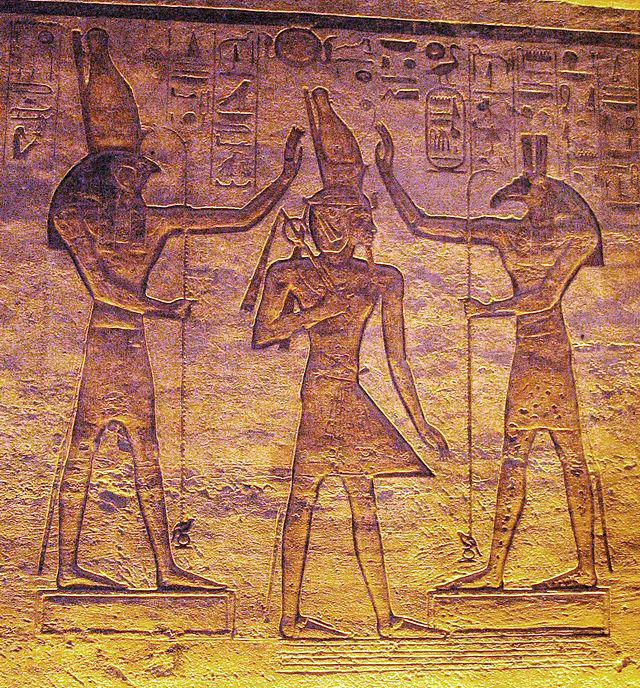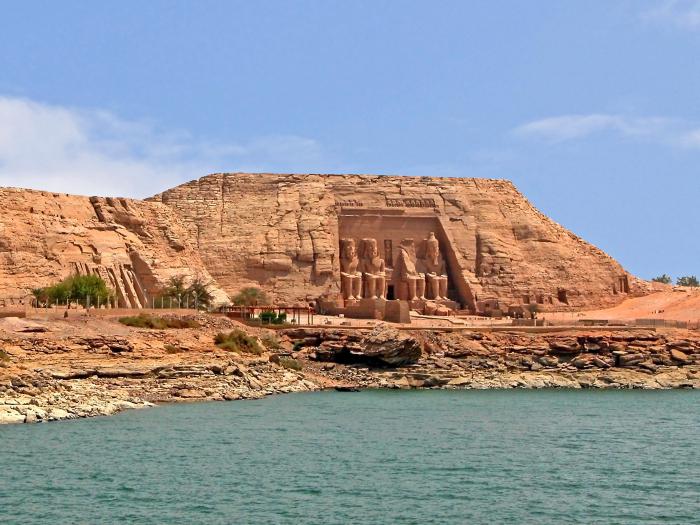In order not to get lost among the sea of offers from various travel agencies, most people try to learn about the sights of Egypt on their own . Now in specialized publications you can find any information about this country and reviews of other tourists. One of the iconic places of the country is the temple of Abu Simbel. But not everyone knows about him. Of course, there are more popular attractions than Abu Simbel. Egypt is primarily known for the pyramids of Giza and the statue of the Sphinx. But just in front of this temple on February 22 and October 22, more than 5 thousand tourists gather.
What attracts them there?
Abu Simbel on the map - a small town lost among the sands of Nubia in northern Egypt, near the border with Sudan. His temples, carved into the rock, stand on the western shore of Lake Nasser. The majestic ensemble was erected in 1244 BC. in honor of the victory of Ramses 2 over the Hittites. More precisely, there are two temples here. The big one is dedicated to the pharaoh and three gods, and the small one is dedicated to the goddess Hathor and the beloved wife of Ramses, the beautiful Nefertari.
In general, during the reign of Ramses 2, five cave temples were erected, but Abu Simbel is rightfully considered the most magnificent of them. Despite the fact that these temples are dedicated to the three gods who patronized the army of the pharaoh, in fact they glorified Ramses 2, who ruled 67 years in Egypt. During this time he conquered 11 countries. His mummy is kept in the Cairo Museum.
Features of the structure and location
The entrance to the Great Temple faces east. The facade is decorated with four twenty-meter statues of the pharaoh, who majestically sits on the throne. Archaeologists are still surprised by the portrait resemblance and the ideal proportions of the sculptures. Moreover, all the statues are the same, only one has its head broken off during the earthquake. At the feet of the pharaoh there are sculptures of wives and children, and the god Ra is depicted above the entrance to the temple .
Halls
Ramses Temple 2 consists of four rectangular rooms, which are gradually reduced. The first room is the most spacious. Its high vault is supported by tetrahedral columns, and the walls are covered with texts and colored reliefs. It contains statues of the pharaoh in the guise of the god Osiris. This room was open to all comers. Only the “noble” could enter the second. The third room, which is even smaller than the previous one, was accessible only to priests. Only the pharaoh and his family could enter the fourth room. It was there that the statues of the gods Harmakis, Amon-Ra and Ptah with the faces of the ruler were located. Everything in the temple speaks of the strength and wealth of Ramses 2: the walls of each hall are adorned with amazing reliefs telling about the hostilities and his life. And the sun and cobra depicted on the ceiling symbolize the power of the state and a fair punishment for those who blamed before the pharaoh.

But after several centuries, the colors faded, and Abu Simbel himself almost completely absorbed the sands of the Sahara. And only at the beginning of the nineteenth century when studying the Hathor temple did a scientist from Switzerland notice fragments of figures, and after large-scale excavations for several years, the Ramses 2 temple was cleared of sand.
For most of the year, penumbra dominates in its halls, and only on the days of the spring and autumn equinoxes, which coincide with the dates of birth and coronation of the pharaoh, can one witness a magnificent spectacle. To see him, crowds of tourists invade Egypt these days. At exactly 5 hours 58 minutes, rising sunlight enters the temple and begins its leisurely journey through its halls. At the end of its journey, the beam glides over Amon-Ra’s shoulder and Ramses 2’s face, lingering for several minutes. They say that at this moment the pharaoh begins to smile.
Then, having moved to the statue of Harmakis, the sunlight leaves the Big Temple without touching the statue of Ptah, the lord of the underworld, who does not need him. Of course, there is no mysticism here, but only a very accurate calculation of Egyptian stargazers and priests.
An interesting mystery of the temple
But there was another mystery in the temple, which was forgotten over time. Every morning at dawn, there were groans and a quiet cry. For a long time no one could explain this phenomenon, but scientists still managed to solve the mystery. It's all about the cracks in the building, or rather, the air temperature. At sunrise, it rose, the cracks widened and began to make these sounds. When they were shut up, the moan ceased.
Small Temple of Abu Simbel: structural features
100 meters from the Great Temple is the Small Temple of Abu Simbel. It is dedicated to the ancient Egyptian goddess of love, Hathor, to whom the features of Nefertari, the elder and beloved wife of the pharaoh , were transferred . They wrote about her as a beautiful and intelligent woman. Only she in the history of ancient Egypt has received such an honor. The small temple looks much more modest and consists of one hall and a sanctuary. On its facade in the niches are statues of Ramses 2 and Nefertari. Skillfully created play of light gives them a special mystery. In the sanctuary is a sculpture of the goddess Hathor in the form of a sacred cow, and in front of it is an image of the pharaoh.

The Abu Simbel complex was located on the bend of the Nile, which was a very important strategic moment. The statues of the pharaoh were clearly visible from afar, personifying the strength and power of the country. They looked especially impressive in the morning, when the rays of the rising sun painted them in a blood red color.
Restructuring
In the 60s of the last century a new danger hung over the temple. The lake, on the shore of which it is located, could completely flood it, and all because of the construction of the Aswan Dam on the Nile. Many projects have been put forward to save the cultural heritage site. They even offered to build an underwater glass dome over the temples. But a unique decision was made - to disassemble the building into blocks and move it to a higher place. The operation was attended by specialists from fifty countries. Over $ 42 million was spent. For four years, this attraction was sawn into separate fragments weighing from 3 to 20 tons, which were numbered and transported to an artificial embankment.

There they were drilled and filled with a resinous compound, which was supposed to strengthen the stone. In total, more than a thousand blocks came out. Reassembled temples were covered with a reinforced concrete cap, and a stone hill was poured on top, which should imitate the rocks. But this was done so carefully that it seemed that the temples stood here for centuries. And once the breakaway head of one of the statues was also moved and very accurately laid at the foot of the temple.
Building study
Thanks to these works, Abu Simbel was carefully studied by archaeologists and experts from UNESCO, who were struck by the art of ancient architects. Having carefully studied the foundation of the building, experts were surprised to find that the facade lines are parallel to the cracks in the rock, this made the temple stable, and the rock formations served as a natural support for huge statues.
Iron oxide, used to strengthen sandstone layers, in addition to its main purpose, gave the stone a variety of bright shades - from lilac to red and even pink. As a result of this operation, the complex was moved 200 m further and 65 m above the level of the lake, and flooding it no longer threatened.
Little conclusion
September 22, Abu Simbel - a temple in Egypt - again takes tourists. The cultural heritage has been preserved for posterity and has become one of the visiting cards of tourist Egypt.